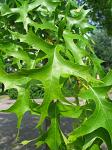Quercus coccinea

- Common name "Scarlet Oak"
- Glossy leaves on both sides, similar to rubra but more deeply lobed (rubra's leaves are only glossy on one side)
- Great Autumn colour
Quercus palustrus

- Likes to grow on very damp marshy soil
- Very deeply lobed leaves, more so than coccinea
- Largest leaves of all Oaks, open and lobate
- Leaves broader above middle - 'obovate'
Platanus orientalis
- Looks similar to Acer but can tell apart because Platanus has no helicopter seed pods, and the leaf nodes are not opposite eachother
Acer griseum
- Has peeling bark
- trifoliatum (three leaflets to each leaf)
- Felted leaves
- Helicopter seed pods
Carpinus betulus 'Incisa'
- Dark green, sharply serated leaves
- A few hairs on petioles
Ostrya carpinifolia
- Common name "hop hornbeam"
- Leaves very similar to Carpinus but larger and hairier - hairs are smaller and more dense
- Seed pods look like large hops
Fagus sylvatica
- Cannot be grown true from seed, it is cultivated
- Long chestnut coloured buds
- Smooth trunk
- Very different leaves to normal Fagus sylvatica (also in test as extra)
Fagus sylvatica

Long narrow buds with rich brown scales make this tree easy to recognise at any time of year.
Other features: Catkins open in May, the male roundish, hanging down on long stalks, and the female upright on shorter stalks. Nuts ripen in Sept-Oct. In most years there are few nuts, but in some years there is a glut of them. Dead leaves remain on the lower branches of young trees all winter.
Acer saccharinum

- Likes damp soil
- Leaves have 5 lobes, more developed than rubrum
- Larger leaves than rubrum and darker underside
Acer rubrum

- Smaller leaves than saccharinum
- Paler undersides
- Young leaves have 3 lobes and develope to 5 lobes as they mature
- Likes damp soil
Fagus grandifolia
- Larger leaves than other Fagus' ("Beech")
- smooth trunk
- Long chestnut coloured buds (typical of all Beech trees)
- Great autumn colour with cold nights and sunny days
Corylus avellana
- Common name "Hazel"
- Has Catkins
- Puckered rough foliage
- Broad leaves with double serate edge
Populus alba
- White underside of leaves
- Also very similar to Populus x canascens ("Grey Poplar") which has grey undersides of leaves
Populus x canascens
Tilia tomentosa
- Common name "Silver Lime"
- Slightly felty hairs on petioles
- Silver underside of broad leaves
Castenea sativa








This is fabulous! HOw exciting!
ReplyDeleteBut are you sure that the quercus coccinea photo is correct? It looks jsut the same as the quercus palustris to me, I remember the coccinea being less lobed than that.
Oh god it's late and I'm still looking at leaves! I think I'm going mad!
Oh the first Fagus sylvatica is 'Asplenifolia'
ReplyDelete